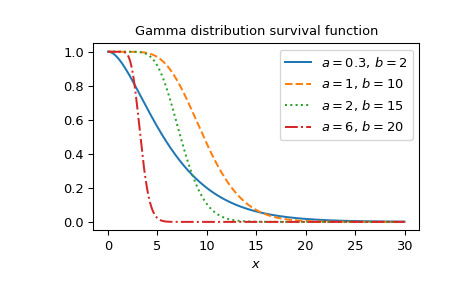本文简要介绍 python 语言中 scipy.special.gdtrc 的用法。
用法:
scipy.special.gdtrc(a, b, x, out=None) = <ufunc 'gdtrc'>#伽马分布生存函数。
伽马概率密度函数从 x 到无穷大的积分,
其中 是伽马函数。
- a: array_like
伽马分布的速率参数,有时表示为(浮点)。它也是比例参数 的倒数。
- b: array_like
伽马分布的形状参数,有时表示为(浮点)。
- x: array_like
分位数(积分下限;浮点数)。
- out: ndarray,可选
函数值的可选输出数组
- F: 标量或 ndarray
参数 a 和 b 的伽马分布的生存函数在 x 处评估。
参数 ::
返回 ::
注意:
使用与不完全伽玛积分(正则化伽玛函数)的关系来进行评估。
Cephes [1] 例程的包装器
gdtrc。与scipy.stats.gamma的sf方法相比,直接调用gdtrc可以提高性能(请参见下面的最后一个示例)。参考:
[1]Cephes 数学函数库,http://www.netlib.org/cephes/
例子:
计算
x=5处a=1和b=2的函数。>>> import numpy as np >>> from scipy.special import gdtrc >>> import matplotlib.pyplot as plt >>> gdtrc(1., 2., 5.) 0.04042768199451279计算函数为
a=1,b=2通过提供 NumPy 数组来在几个点上x.>>> xvalues = np.array([1., 2., 3., 4]) >>> gdtrc(1., 1., xvalues) array([0.36787944, 0.13533528, 0.04978707, 0.01831564])gdtrc可以通过提供具有广播兼容形状的数组来评估不同的参数集a,b和x。这里我们计算三个不同的函数a在四个位置x和b=3,产生一个 3x4 数组。>>> a = np.array([[0.5], [1.5], [2.5]]) >>> x = np.array([1., 2., 3., 4]) >>> a.shape, x.shape ((3, 1), (4,))>>> gdtrc(a, 3., x) array([[0.98561232, 0.9196986 , 0.80884683, 0.67667642], [0.80884683, 0.42319008, 0.17357807, 0.0619688 ], [0.54381312, 0.12465202, 0.02025672, 0.0027694 ]])绘制四个不同参数集的函数。
>>> a_parameters = [0.3, 1, 2, 6] >>> b_parameters = [2, 10, 15, 20] >>> linestyles = ['solid', 'dashed', 'dotted', 'dashdot'] >>> parameters_list = list(zip(a_parameters, b_parameters, linestyles)) >>> x = np.linspace(0, 30, 1000) >>> fig, ax = plt.subplots() >>> for parameter_set in parameters_list: ... a, b, style = parameter_set ... gdtrc_vals = gdtrc(a, b, x) ... ax.plot(x, gdtrc_vals, label=f"$a= {a},\, b={b}$", ls=style) >>> ax.legend() >>> ax.set_xlabel("$x$") >>> ax.set_title("Gamma distribution survival function") >>> plt.show()
伽马分布也可用作
scipy.stats.gamma。直接使用gdtrc比调用scipy.stats.gamma的sf方法要快得多,特别是对于小型数组或单个值。为了获得相同的结果,必须使用以下参数化:stats.gamma(b, scale=1/a).sf(x)=gdtrc(a, b, x)。>>> from scipy.stats import gamma >>> a = 2 >>> b = 3 >>> x = 1. >>> gdtrc_result = gdtrc(a, b, x) # this will often be faster than below >>> gamma_dist_result = gamma(b, scale=1/a).sf(x) >>> gdtrc_result == gamma_dist_result # test that results are equal True
相关用法
- Python SciPy special.gdtr用法及代码示例
- Python SciPy special.gdtria用法及代码示例
- Python SciPy special.gdtrix用法及代码示例
- Python SciPy special.gdtrib用法及代码示例
- Python SciPy special.gamma用法及代码示例
- Python SciPy special.genlaguerre用法及代码示例
- Python SciPy special.gammaincinv用法及代码示例
- Python SciPy special.geterr用法及代码示例
- Python SciPy special.gammasgn用法及代码示例
- Python SciPy special.gammainc用法及代码示例
- Python SciPy special.gammaln用法及代码示例
- Python SciPy special.gammainccinv用法及代码示例
- Python SciPy special.gegenbauer用法及代码示例
- Python SciPy special.gammaincc用法及代码示例
- Python SciPy special.exp1用法及代码示例
- Python SciPy special.expn用法及代码示例
- Python SciPy special.ncfdtri用法及代码示例
- Python SciPy special.y1用法及代码示例
- Python SciPy special.y0用法及代码示例
- Python SciPy special.ellip_harm_2用法及代码示例
- Python SciPy special.i1e用法及代码示例
- Python SciPy special.smirnovi用法及代码示例
- Python SciPy special.ker用法及代码示例
- Python SciPy special.ynp_zeros用法及代码示例
- Python SciPy special.k0e用法及代码示例
注:本文由纯净天空筛选整理自scipy.org大神的英文原创作品 scipy.special.gdtrc。非经特殊声明,原始代码版权归原作者所有,本译文未经允许或授权,请勿转载或复制。
